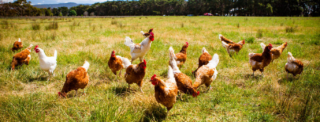- Resources
- Poultry Sustainability Guide holds the keys to sustainability on the farm and in production
Resources
Poultry Sustainability Guide holds the keys to sustainability on the farm and in production
Published: July 9, 2019 by Theresa Eberhardt
We eat a lot of chicken. I see this just from my own family’s consumption of barbecue chicken at our July 4th cookout last week; but consumption trends also show that demand for chicken is steadily increasing among Americans.
Eating chicken instead of other meats is perceived to be the more eco-friendly choice as poultry has a smaller environmental footprint overall. However, poultry processing is actually very energy-intensive.
In fact, 41% of emissions within the chicken supply chain are the result of energy use. Let this fact sink in: producing chicken in the U.S. each year is equivalent to the emissions of driving 6 million cars.

This presents a huge opportunity to scale sustainability solutions to a growing industry that is ripe for change. To meet this opportunity, EDF talked with trusted academics; farmers; organizations, including the U.S. Roundtable for Sustainable Poultry & Eggs and U.S. Poultry & Egg Association; and companies such as Tyson Foods and Perdue to develop the Poultry Sustainability Guide.
The result is a user-friendly how-to guide with best practices and actionable solutions that the poultry industry can use now on the farm or in the plant. This guide is geared toward those who are just getting started with environmental sustainability in the poultry industry.
Here are the key opportunities and next steps outlined in the Poultry Sustainability Guide:
- On the plant level, energy use, refrigeration, waste management and water use are where to focus efforts and where financial savings exist. For example, there are substantial energy savings to be gained in a poultry processing plant by assessing current energy performance. The EPA is requiring some harmful, ozone-depleting refrigerants at poultry plants to be phased out by January 2020, so getting ahead of this deadline will benefit your operations.
- At the farm, there are four major areas to focus on improving to achieve significant greenhouse gas and water quality improvements: feed production, waste and litter management, on-farm equipment and water use. The solution comes down to using these resources more effectively and efficiently, which also helps cut costs.
- Once you set your goals and metrics for a more sustainable, eco-friendly and likely cost-saving poultry operation, we’ve got everything you need to implement your plan. This includes determining who you need to engage with at the plant level and in your supply chain and creating reporting and evaluation structures to track and revise your plan as needed.
Before the Poultry Sustainability Guide, nothing like this existed to help the poultry industry tackle climate change at the plant- and farm-level. This is just one more resource we’ve added to our growing collection of sustainability 101, intermediate and advanced resources for corporate professionals on the Supply Chain Solutions Center.
Follow Theresa on Twitter.
Follow EDF+Business on Twitter.
